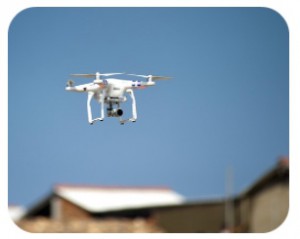 In 2013 Amazon announced a bold new venture: a drone delivery service that could bring products to customers within 30 minutes. Three years later, the e-commerce giant completed its first Amazon Prime Air delivery during a trial run in Great Britain. Of course, the company still has a long way to go before its drones are ready to take flight in great numbers. Along with figuring out many technical details, Amazon must also deal with regulations that limit where drones can and cannot fly. In the U.S., for instance, drones are not allowed to soar above densely populated areas.
In 2013 Amazon announced a bold new venture: a drone delivery service that could bring products to customers within 30 minutes. Three years later, the e-commerce giant completed its first Amazon Prime Air delivery during a trial run in Great Britain. Of course, the company still has a long way to go before its drones are ready to take flight in great numbers. Along with figuring out many technical details, Amazon must also deal with regulations that limit where drones can and cannot fly. In the U.S., for instance, drones are not allowed to soar above densely populated areas.
As a result, Amazon has established research facilities in Great Britain, Austria and France in order to test its drones in less regulated skies. At its British outpost, the company currently has two customers enrolled in a pilot program for Prime Air. While this lucky pair have made headlines for receiving Amazon’s first drone-delivered packages, perhaps the company‘s most important work is being done at its R&D center in France. In this facility located near Paris, about a dozen software engineers and aviation experts are building an air-traffic control system for the company’s growing drone fleet.
Amazon researchers first tried to adapt air-traffic methods used by airlines only to discover that these techniques didn’t work with low-flying drones. Instead, they began to develop a system that focuses on guiding drones past obstacles like power lines, buildings, and birds. This approach relies on creating detailed maps that include temporary objects like construction cranes as well as up-to-the-second weather conditions. What’s more, the autonomous drones will also be able to warn each other in real-time if they encounter any risks on a flight. Despite these latest advancements, though, there’s still no telling when Amazon Prime Air will be ready to go live. “This is highly regulated,” said Amazon’s VP for global innovation policy Paul Misener. “We’re not going to launch this until we can demonstrate its safety.”
Questions:
- Should the U.S. put new regulations in place that make it easier for companies to test drones?
- Why must Amazon develop an entirely new air-traffic control system for its drones?
Source: Adam Satariano and Marie Mawad, “Why Amazon’s Delivery-Drone Team Is Obsessed With Geese,” Bloomberg, May 18, 2017; Frederic Lardinois, “Amazon Starts Prime Air Drone Delivery Trial in the UK — But Only With Two Beta Users,” TechCrunch, December 14, 2016.
